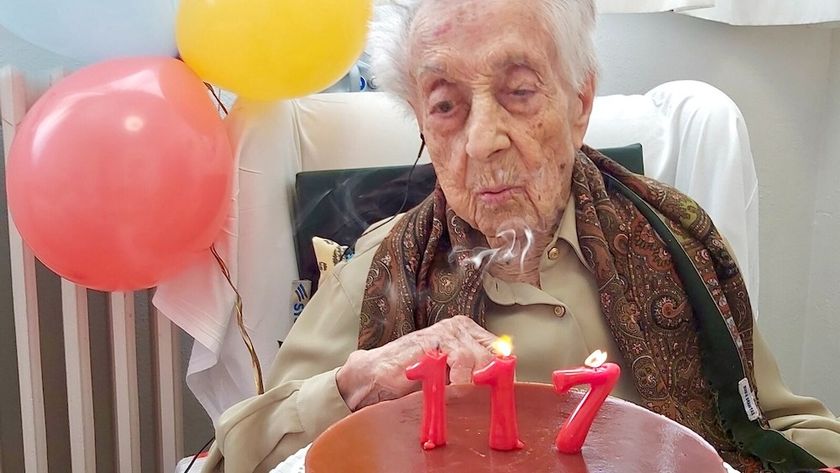New Anti-Aging Clinical Trial Begins. For $1 Million, You Can Be a Participant.
A Kansas-based company launched a clinical trial in Colombia to reverse aging. But will it work?

An American biotech company has launched clinical trials in Colombia to test a new therapy designed to reverse the aging process, and in turn, treat age-related diseases, according to news reports.
But to steal a sip from this purported fountain of youth, participants in the trial must first fork over $1 million — a fee that seems even more astronomical when you consider that most clinical trials are either free or provide participants with financial compensation, according to a report by OneZero, a Medium publication about tech and science.
The pricey trial is being run by Libella Gene Therapeutics, a Kansas-based company whose website proclaims that "the future is here." The company announced its intention to test its anti-aging remedies in Cartagena, Colombia, in 2018, and began recruiting for the trials in October of this year. Using a single-gene therapy, Libella aims to "prevent, delay, or even reverse" the general effects of aging, as well as treat diseases that emerge in old age, such as Alzheimer's, according to ClinicalTrials.gov.
In fact, in its own press release, the company boasted, without evidence, that its gene therapy "may be the world's first cure for Alzheimer's disease." The bold claim raises an obvious question: Will the treatment actually work?
Short answer: No one really knows, but the fact that Libella shipped its operation beyond the reach of the U.S. Food and Drug Administration (FDA) doesn't inspire confidence, experts told OneZero.
Related: 5 Reasons Not to Fear Getting Older
A cure for aging?
Unlike anti-aging face creams that soften the superficial signs of aging, the Libella therapy aims to reverse aging from the ground up, so to speak, starting at the level of our genes. Specifically, the gene therapy is intended to lengthen patients' telomeres — structures that cap the tips of chromosomes and prevent the genetic material inside from fraying. Telomeres grow shorter each time a cell divides, and when the structures reach a critical length, cells either stop dividing or perish, according to Stanford Medicine.
Sign up for the Live Science daily newsletter now
Get the world’s most fascinating discoveries delivered straight to your inbox.
The theory goes, if you rebuild the body's shortened telomeres, the process of aging might be thrown in reverse. This is not a new idea. Several studies in mice suggest that using gene therapy to lengthen telomeres can reverse certain signs of aging in the animals. A 2015 study from Stanford prompted similar effects in isolated human cells; the treatment lengthened cells' telomeres by fiddling with a close cousin of DNA, called RNA, which helps cells build proteins.
The Libella therapy aims to help cells rebuild telomeres by activating a gene in their DNA that would normally be switched "off." The gene, called TERT, contains instructions to build a protein called "telomerase," an enzyme that adds molecules to the end of telomeres and prevents the structures from shortening during cell replication, according to a 2010 report in the journal Biochemistry.
Libella's lead scientific officer, molecular biologist William Andrews, originally helped identify the human telomerase enzyme at the biotech firm Geron. Later, he licensed a gene therapy based on the finding to Libella, according to OneZero. "I can't say [telomere shortening is] the only cause of aging, but it plays a role in humans," Andrews told the publication.
Related: 8 Tips for Healthy Aging
Andrews' therapies will soon be put to the test in Colombia, where one 79-year-old will receive the anti-aging treatment in next month, according to OneZero. The anti-aging trial will include four more participants over age 45 and focus on verifying that the treatment is "safe and tolerable," meaning it does not harm patients or cause unacceptable side effects.
Two more trials will use the same therapy but aim to "prevent, delay, or even reverse the development" of Alzheimer's disease and critical limb ischemia, an age-related condition in which a person's arteries become severely obstructed. Participants in these trials must already be diagnosed with the disorders.
After treatment, participants in all three trials will remain in the clinic for 10 days for further monitoring, and then return at regular intervals for checkups over the following year.
Experts are concerned
Libella's gene therapy involves a one-time injection delivered through an IV; the Alzheimer's therapy uses the same formula but doctors inject the product into the patient's spinal fluid. Within the product, a modified virus carries the TERT gene into cells and injects the genetic material into their DNA. The modified viruses cannot transmit diseases to people, but in high enough doses, the germs could provoke a harmful immune response in the patient, according to a 2018 animal study. Libella representatives declined to say how high a dose their clinical trial participants will receive.
"All I can say is, it's a lot," Andrews told OneZero.
Potential side effects aside, the fact that the Libella treatment will be administered beyond the purview of the FDA is telling, according to one expert. Leigh Turner, a bioethicist at the University of Minnesota, told OneZero that "even though the company is based in the United States, they've managed to find a way to evade U.S. federal law by going to a jurisdiction where it's easier to engage in this activity."
The $1 million entry fee is also alarming, Turner said, given that most clinical trials don't charge patients anything to enter. Andrews told OneZero that the fee is justified because it costs the company hundreds of thousands of dollars to make enough product to treat just one person.
The appearance of the trials on ClinicalTrials.gov, an official registry maintained by the National Institutes of Health, does not boost their credibility, she added. The automated database can be easily manipulated and "can basically be used as a marketing platform," she said.
Other stakeholders in the telomere-lengthening business are concerned, too. Michael Fossel, founder and president of the biotech startup Telocyte, told OneZero that his company's own therapy is similar to the Libella treatment — the difference is that Telocyte is seeking approval through the FDA. "We're afraid that something will go wrong [with the Libella trials], whether it's from a safety or efficacy standpoint," he said.
Related: Extending Life: 7 Ways to Live Past 100
But even in a best case scenario, wherein no patients come to harm, the Libella therapy still might not deliver any notable health benefits. Some research suggests that no link exists between telomere length and aging.
For instance, a study published this year examined more than 261,000 people between age 60 and 70, and found no correlation between participants' telomere lengths and their age-related health outcomes, including their overall cognitive function, muscular integrity and the age of their parents. Long telomeres were associated with a lowered risk of coronary heart disease as compared with short telomeres, but longer telomere length was also linked to a heightened risk of cancer.
"Telomere lengthening may offer little gain in later‐life health status" and lead to an increased risk of cancer, the authors noted.
It remains to be seen whether Libella has truly tapped the fountain of youth, but given the dubious nature of their clinical trials, potential participants may want to exercise caution before relocating to Colombia and shelling out $1 million for a chance to live longer.
- 5 Reasons Aging Is Awesome
- 7 Ways the Mind and Body Change With Age
- Genetics by the Numbers: 10 Tantalizing Tales
Originally published on Live Science.

Nicoletta Lanese is the health channel editor at Live Science and was previously a news editor and staff writer at the site. She holds a graduate certificate in science communication from UC Santa Cruz and degrees in neuroscience and dance from the University of Florida. Her work has appeared in The Scientist, Science News, the Mercury News, Mongabay and Stanford Medicine Magazine, among other outlets. Based in NYC, she also remains heavily involved in dance and performs in local choreographers' work.











